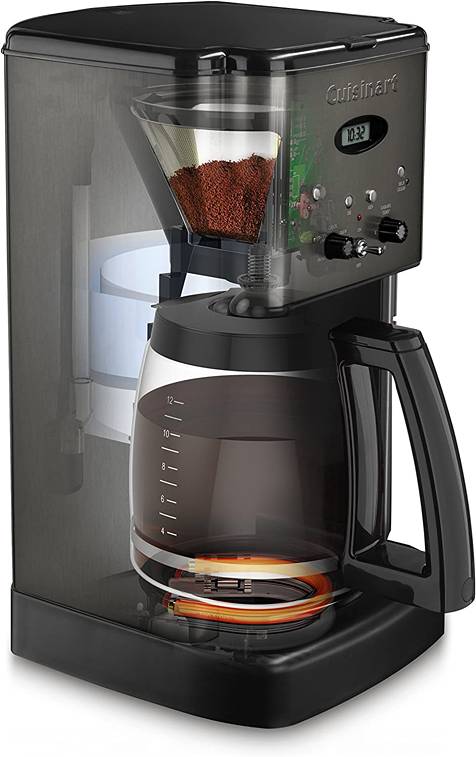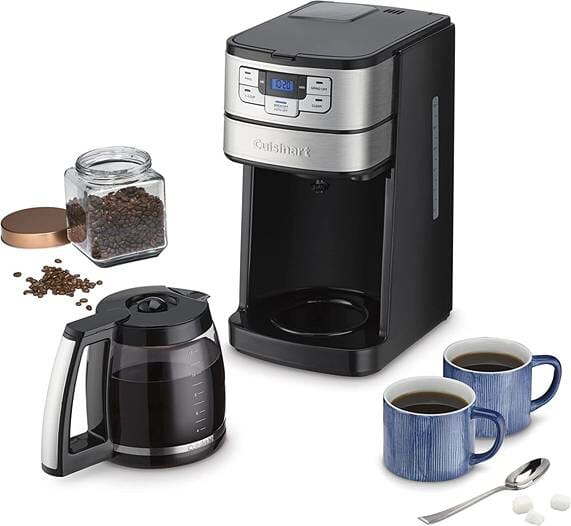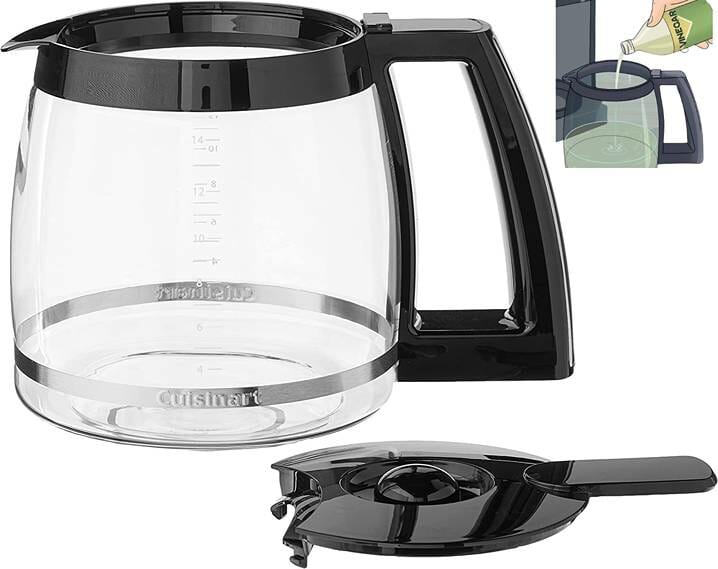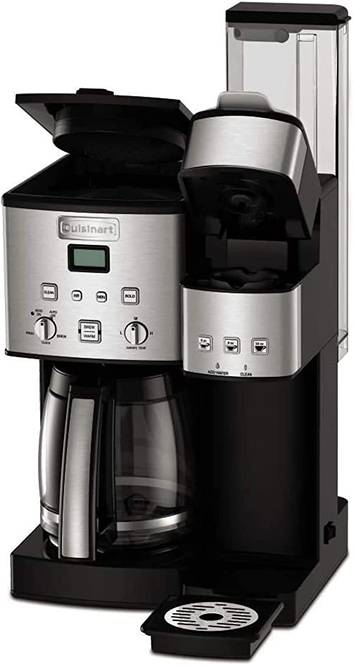If you own a Cuisinart Coffee Maker, you’ve probably grown accustomed to a very low-maintenance relationship with the great-tasting coffee you brewed at home.
Cuisinart coffee makers are easily some of the most well-known and beloved in the world.
As far as a simple drip coffee maker goes, the Cuisinart coffee maker is seen by many as the best electric coffee maker for home use.
It’s sleek in style, well-made, reliable in function, and many even boast an automatic coffee machine cleaning cycle that further minimizes the effort one needs to put into getting the most from their home coffee machine.
How to clean a Cuisinart Coffee Pot?
Whether your Cuisinart coffee maker boasts one of the famous “clean light” buttons that triggers a built-in cleaning cycle or not, one thing remains certain: for casual coffee drinkers, the only things better than Cuisinart coffee makers are clean Cuisinart coffee makers.
- How to Clean a Cuisinart Coffee Pot & Machine
- Why Do You Need to Clean Cuisinart Coffee Maker?
- Important Precautions Before Beginning the Cuisinart Coffee Maker Cleaning Process
- Instructions to Clean Your Cuisinart Coffee Maker
- What if the Self Clean Light Stays On After The Cleaning Cycle on a Coffee Machine?
- Can I Just Use the Self-Clean Process Without Manually Cleaning Coffee Maker?
How to Clean a Cuisinart Coffee Pot & Machine

Fortunately, getting your coffee maker back to like-new cleanliness is a quick and straightforward process regardless of whether or not you use (or have) the cleaning cycle function on your Cuisinart coffee machine.
Use a Vinegar Solution, Not Dish Soap or Chemicals for Coffee Maker
The best approach employs a simple white vinegar solution mix to descale the innards of the Cuisinart coffee machine, plus some additional filtered water and possibly some baking soda.
You do not need—and we advise you not to use—any harsh cleaning liquids or in most cases even soapy water (although you can wash your carafe and water reservoir with some old-fashioned warm water and soap).
But before you begin, there are some important steps you should take and things you may want to understand about your coffee maker.
Why Do You Need to Clean Cuisinart Coffee Maker?
Like any electric coffee maker, the Cuisinart coffee maker is an intricate device that repeatedly handles both water and coffee grounds.
Over time, several subtle effects of normal use compound and can cause problems with how the coffee maker functions.
At the very least, without a proper regular cleaning cycle and some loving attention from you, your Cuisinart coffee maker simply won’t work as well, and your coffee will end up tasting noticeable off.
Stuck On Coffee Residue & Ground Coffee
The first major contributor to the inevitable degradation of your Cuisinart coffee machine is the coffee itself.
Ground coffee is an organic compound, which means it decays naturally over time like all organic substances.
Your coffee maker is an intricate machine with lots of little crevices and corners where fine particles like coffee grinds can easily lodge themselves and get stuck
They then begin to break down and eventually rot, allowing nasty bacteria to thrive inside your beautiful Cuisinart coffee maker.
Mold and Mildew
Now add water to the equation, and you’ve got a potential mold problem. Bacteria in your coffee is bad enough without adding mold spores.
Both of these hazards can become a real problem if you leave your Cuisinart coffee maker for too long without putting it through a cleaning cycle.
Not only is this just generally gross, but it will also significantly affect the taste of your coffee the longer you allow it to persist. It’s also a health risk. Yuck.
Mineral Deposits From Your Water Reservoir

The second issue that’s totally unavoidable as you use your Cuisinart coffee maker is the formation of mineral deposits.
No matter what type of water you use—filtered water, boiled water, bottled water—it all contains a certain amount of minerals in the form of dissolved solids.
Normally these are totally ok to ingest, and in fact most of them are important for nutritional balance.
But when water sits in different parts of your coffee maker over time, it eventually evaporates and leaves those formerly dissolved minerals behind to pile up inside the coffee machine.
While not as much of a potential health issue as decaying coffee tends to be, mineral buildup will directly impede the ability of your Cuisinart coffee machine to function normally.
This mineral buildup literally clogs the passageways of the device.
It can also impact the taste of your coffee.
Important Precautions Before Beginning the Cuisinart Coffee Maker Cleaning Process
A few important warnings before you begin your cleaning cycle.
If cleaning by hand, be sure to switch off and unplug your Cuisinart coffee maker to avoid the risk of electric shock. This includes when using a damp cloth to wipe down the heating plate.
When cleaning your water reservoir, don’t forget to first remove the charcoal water filter. You should also plan to replace the charcoal water filter every 3-6 months.
Soapy water rinse can be used to clean the removable parts of your coffee maker, like the filter basket, carafe, and water reservoir, but we highly recommend avoiding dish soap and especially any chemical or abrasive cleaner inside the coffee maker itself.
After cleaning is complete, be sure to let every part dry fully before putting the coffee maker pieces back together. This will help prevent mold and mildew from forming.
Instructions to Clean Your Cuisinart Coffee Maker
If your coffee maker has a self-clean button, you’re in luck. Most of the work will be done for you.
So, here are instructions on how to clean a Cuisinart Coffee maker:
Step 1
The most important thing you can do when using the self-clean process is to use a white vinegar solution comprised of 1 part vinegar and 2 parts water. You can fill up the water reservoir using this vinegar solution, but be sure to remove the charcoal water filter first.
Step 2
Press the button with the self-clean light to begin the process.
Step 3
After the cleaning cycle has completed, open up your coffee maker, dismantle the removable components, and give it a nice thorough wipe down with a damp cloth.
Step 4
Next step, you can focus on the filter basket and carafe, soaking both pieces in your vinegar solution to ensure all the mineral deposits are fully dissolved and washed clean.
Step 5
Thoroughly rinse your filter basket and carafe in warm water. If you’d like, you can use soapy water for these parts as well. Just be sure to rinse them thoroughly before putting them back in the coffee machine, so there’s no faint taste of soap in your next cup of coffee.
Step 6
For good measure, in this step fill up your water tank once more with only purified water and run the cleaning process once more. This will ensure there’s no aftertaste from the vinegar solution.
What if I don’t have a self-clean button?
Not to worry! You can apply the same steps above, simply using the brewing cycle instead.
It will similarly saturate the internals of the coffee maker with the vinegar solution, which will go a long way to clean it out while brewing.
What if the Self Clean Light Stays On After The Cleaning Cycle on a Coffee Machine?
This is a very common issue owner of a Cuisinart coffee maker tend to face. So common, in fact, that we’ve dedicated a full informative article to the topic.
The short of it is, most times when the clean light (or the light around the self-clean button) stays on after you’ve done a full cleaning cycle, it just needs to be cleaned again.
If it’s been a while since you’ve done a full clean, or you live in an area with hard water (which has a high mineral content), build-up may be much more substantial and require a bit more effort to remove before that self-clean light decided your cleaning cycle was adequate.
If it still refuses to turn off after multiple cleaning cycles, you can try lightly scrubbing with some baking soda and then following up with another clean cycle using only warm purified water.
If after all of these steps you still can’t get that self-clean light off, it may be time to contact customer support or bring your coffee maker in to be looked at.
Having other issues with your Cuisinart Coffee Maker? Check out our Troubleshooting guide here.
Can I Just Use the Self-Clean Process Without Manually Cleaning Coffee Maker?
Yes and no.
You can use the self-clean button to drastically reduce the amount of manual coffee maker’s cleaning you’ll need to do, but inevitably there will be some hand cleaning necessary over a life-time.
Of course, most of the removable parts of the coffee maker, like the coffee carafe and water reservoir, can’t be cleaned using the automatic cleaning cycle.
In addition, the automatic self-clean process is really meant to descale the internals of the machine and remove mineral buildup.
It’s not going to effectively eliminate packed-in pockets of old coffee grinds or sufficiently perform an internal cleaning if there’s mold or other significant contaminants lingering inside.
Check out the article here on how to use the Cuisinart Coffee Maker properly?



